What do they do?
Assist ophthalmologists by performing ophthalmic clinical functions. May administer eye exams, administer eye medications, and instruct the patient in care and use of corrective lenses.
Also known as:
Certified Ophthalmic Medical Technician (Certified Ophthalmic Medical Tech), Certified Ophthalmic Surgical Assistant, Certified Ophthalmic Technician (COT), Certified Ophthalmic Technician-Surgical Assistant (COT-SA), Health Technician (Health Tech), Ophthalmic Assistant, Ophthalmic Diagnostic Sonographer, Ophthalmic Medical Assistant, Ophthalmic Medical Technician (Ophthalmic Medical Tech), Ophthalmic Tech (Ophthalmic Technician)
-
2.5%
Change
Ranks #47 in job growth rate390Job Openings
Ranks #9 in net job growth
Looking for colleges that offer a specific major? Use the College Match Tool to find your best-matched schools and discover your estimated Net Price!
- High school diploma equivalent (43%)
- Some college, no degree (23%)
- Associate's degree (12%)
- Bachelor's degree (11%)
- Less than high school diploma (9%)
- Master's degree (2%)
- Doctorate or Professional Degree (1%)
People in this career often know a lot about:
- Customer and Personal Service - Knowledge of principles and processes for providing customer and personal services. This includes customer needs assessment, meeting quality standards for services, and evaluation of customer satisfaction.
- Medicine and Dentistry - Knowledge of the information and techniques needed to diagnose and treat human injuries, diseases, and deformities. This includes symptoms, treatment alternatives, drug properties and interactions, and preventive health-care measures.
- English Language - Knowledge of the structure and content of the English language including the meaning and spelling of words, rules of composition, and grammar.
- Mathematics - Knowledge of arithmetic, algebra, geometry, calculus, statistics, and their applications.
People in this career often have talent in:
- Oral Comprehension - The ability to listen to and understand information and ideas presented through spoken words and sentences.
- Oral Expression - The ability to communicate information and ideas in speaking so others will understand.
- Near Vision - The ability to see details at close range (within a few feet of the observer).
- Speech Clarity - The ability to speak clearly so others can understand you.
- Written Expression - The ability to communicate information and ideas in writing so others will understand.
- Problem Sensitivity - The ability to tell when something is wrong or is likely to go wrong. It does not involve solving the problem, only recognizing that there is a problem.
People in this career often do these activities:
- Collect medical information from patients, family members, or other medical professionals.
- Record patient medical histories.
- Test patient vision.
- Measure the physical or physiological attributes of patients.
- Operate diagnostic or therapeutic medical instruments or equipment.
- Administer non-intravenous medications.
- Assist healthcare practitioners during surgery.
- Sterilize medical equipment or instruments.
- Clean medical equipment or facilities.
- Maintain medical equipment or instruments.
- Instruct patients in the use of assistive equipment.
- Monitor patients following surgeries or other treatments.
- Fit eyeglasses, contact lenses, or other vision aids.
- Recommend types of assistive devices.
This page includes data from:

 Occupation statistics: USDOL U.S. Bureau of Labor Statistics Occupational Employment Statistics
Occupation statistics: USDOL U.S. Bureau of Labor Statistics Occupational Employment Statistics
 Videos: CareerOneStop, USDOL/ETA and the Minnesota Department of Employment & Economic Development
Videos: CareerOneStop, USDOL/ETA and the Minnesota Department of Employment & Economic Development





